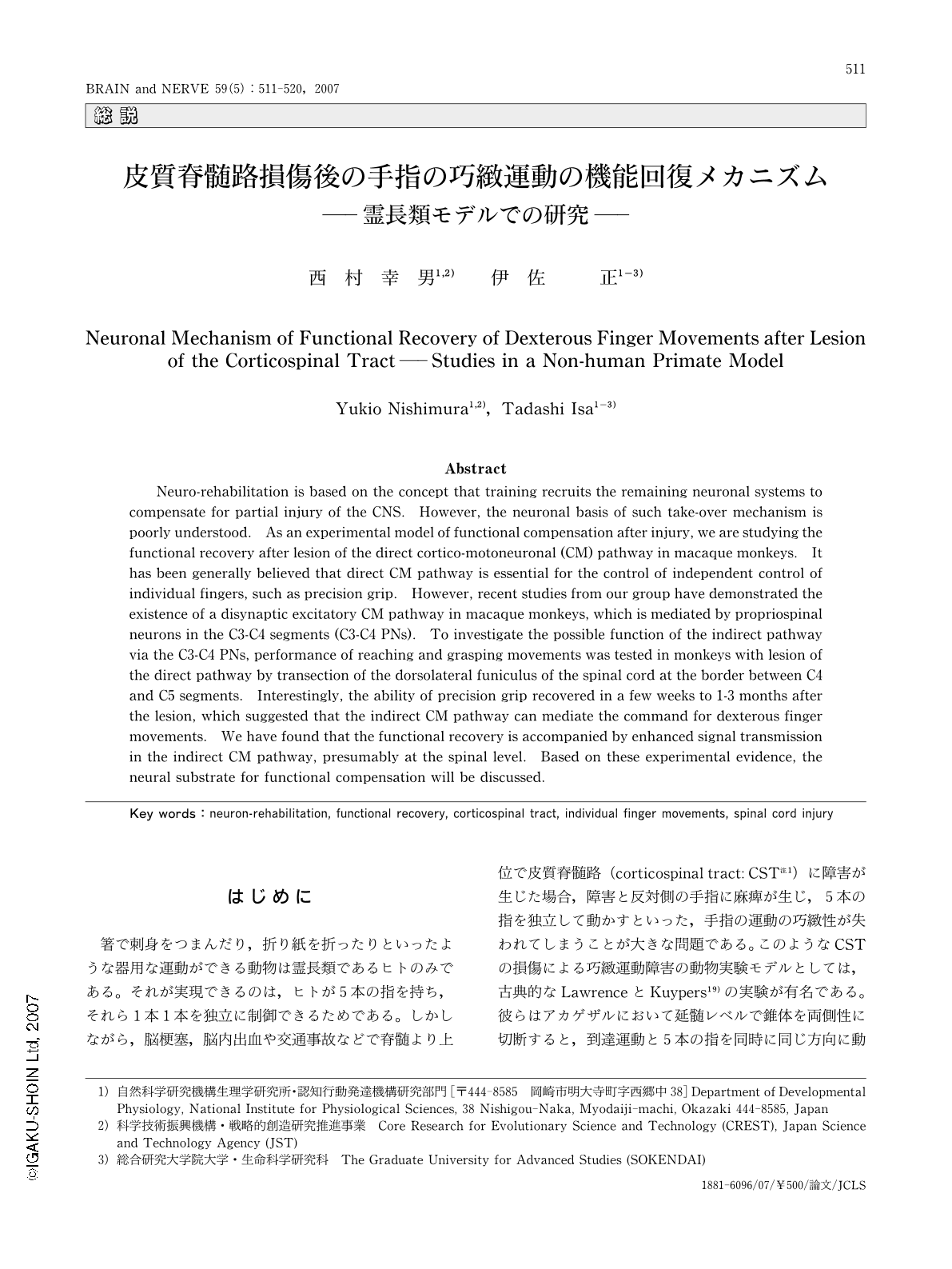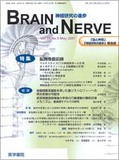Japanese
English
- 有料閲覧
- Abstract 文献概要
- 1ページ目 Look Inside
- 参考文献 Reference
はじめに
箸で刺身をつまんだり,折り紙を折ったりといったような器用な運動ができる動物は霊長類であるヒトのみである。それが実現できるのは,ヒトが5本の指を持ち,それら1本1を独立に制御できるためである。しかしながら,脳梗塞,脳内出血や交通事故などで脊髄より上位で皮質脊髄路(corticospinal tract:CST注1)に障害が生じた場合,障害と反対側の手指に麻痺が生じ,5本の指を独立して動かすといった,手指の運動の巧緻性が失われてしまうことが大きな問題である。このようなCSTの損傷による巧緻運動障害の動物実験モデルとしては,古典的なLawrenceとKuypers19)の実験が有名である。彼らはアカゲザルにおいて延髄レベルで錐体を両側性に切断すると,到達運動と5本の指を同時に同じ方向に動かし,まとめて物をつかむといった運動(power grip)はある程度回復しても,個々の指を独立して動かす精密把持(Fig.1A)のような巧緻運動は永久に失われてしまうと報告した(Fig.1B)。
CSTは系統発生学的に新しい経路で,霊長類において大きく発達を遂げ,脊髄運動神経細胞(spinal motoneuron:MN)との直接結合(単シナプス性結合)をつくるようになる(Fig.1C)。そして手指の独立制御や巧緻性も霊長類において大きく発展を遂げる。またさまざまな霊長類種の間で比較を行うと,この直接結合の発達と手指の巧緻性の間には相関があるとされている4,9)。これらの観察結果と上記のLawrenceとKuypersら19)の研究をはじめとする損傷実験の結果から,一般には錐体路が運動ニューロンと直接結合することが,手指の巧緻性の原因であると考えられてきた。
しかし,LawrenceとKuypers19)自身がその論文の中で書いているように,彼らの損傷は「CSTからMNないしは脊髄介在ニューロン系注2)に対する入力を遮断したもの」であって,必ずしもMNへの直接投射を遮断しただけではない(Fig.1D)。したがってCST から脊髄介在ニューロン系への経路が重要な役割りを果たしていることが想像されるが,これまで霊長類でのCSTの運動制御に対する機能に関する研究は,そのMNへの直接経路に限られており,脊髄介在ニューロン系への投射がもつ機能については必ずしも注意が払われてこなかった。
Abstract
Neuro-rehabilitation is based on the concept that training recruits the remaining neuronal systems to compensate for partial injury of the CNS. However,the neuronal basis of such take-over mechanism is poorly understood. As an experimental model of functional compensation after injury,we are studying the functional recovery after lesion of the direct cortico-motoneuronal (CM)pathway in macaque monkeys. It has been generally believed that direct CM pathway is essential for the control of independent control of individual fingers,such as precision grip. However,recent studies from our group have demonstrated the existence of a disynaptic excitatory CM pathway in macaque monkeys,which is mediated by propriospinal neurons in the C3-C4 segments (C3-C4 PNs). To investigate the possible function of the indirect pathway via the C3-C4 PNs,performance of reaching and grasping movements was tested in monkeys with lesion of the direct pathway by transection of the dorsolateral funiculus of the spinal cord at the border between C4 and C5 segments. Interestingly,the ability of precision grip recovered in a few weeks to 1-3 months after the lesion,which suggested that the indirect CM pathway can mediate the command for dexterous finger movements. We have found that the functional recovery is accompanied by enhanced signal transmission in the indirect CM pathway,presumably at the spinal level. Based on these experimental evidence,the neural substrate for functional compensation will be discussed.

Copyright © 2007, Igaku-Shoin Ltd. All rights reserved.


